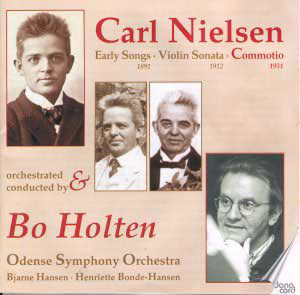This is very much a joint effort. The composer Bo Holten has
created idiomatic orchestral versions of two of Nielsen's major works
(one for organ; the other for violin and piano duo) and provided orchestral
accompaniments for seven early songs - one to words by Ludvig Holstein;
the others to poems by Jens Peter Jacobsen. Everything on the disc is
a Holten arrangement. Authenticity of interpretation is secured by having
Holten as the conductor.
The symbolism of the CD cover is symmetrically rounded
with three photos of Nielsen at the differing ages at which he wrote
the three works. Holten, the arranger, is also pictured there.
Commotio, originally for solo
organ is Nielsen's last major work. Some readers might remember it from
a Turnabout LP of the early 1970s. It formed the most interesting part
of a collection of Nielsen's organ works. It is a very late work post-dating
the Sixth Symphony. Its organ credentials are enthusiastically embraced
by Holten. Echt Nielsen touches abound - listen to 3.12 which has the
same quality of softly lilting woodwind that you hear in the pastoral
stretches of symphonies 3, 4 and 5. Other sections sound grandiloquently
Regerian. The warmly eruptive horns at 14.12 are straight out of the
Fourth and Fifth symphonies. Incidentally this work gives some speculative
insight into what Nielsen's last symphony might have sounded had he
managed a Sibelian seven rather than a very individual six.
The 1912 Violin Sonata is rendered as a violin
concerto with many authentic touches of Nielsen-style orchestration
and capricious character painting. You can hear the caprice in the ‘hiccups’
in the violin part in the allegro piacevole. The work unnervingly
opens and closes in understatement - completely unconventional. Bjarne
Hansen (leader of the Odense SO) was well chosen for the project. He
is secure and pure of tone and plays up to the temperamental character
of the piece whether as a village grotesque or an ingénu serenader.
His playing is rapt and thoughtful throughout the Molto adagio (second
of three movements) and explosively insistent in the Allegro piacevole
which ends most unpeacefully.
The Seven Songs stand to be judged both in relation
to their performance and orchestration and as a cogently formed cycle.
They are all early - very early. Aeblomst is not far removed
from the volkslieder of Brahms - fond, light and airy. The tradition
observed by Nielsen traces its way forward from Brahms to Mahler to
Schoeck (although these Nielsen songs do not reek of depression) and
even to Eisler in his 'Hollywood' songs. Dr Daniel Grimley in his notes
for the disc points to the Mahler influence which is accentuated by
the Holten orchestrations. Holten makes refined and subtle choices time
after time. In the dirge-like chanty of Det bødes der for
the long sustained high pppp from the violins is masterful.
Henriette Bonde-Hansen's melisma in Genrebillede is beautifully
weighted and spun. Bonde-Hansen's voice has a dark tincture and an operatic
torque which is valuable in several of these songs looking consciously
or otherwise toward Wagner. Irmelin Rose, Nielsen's best known
(least unknown?) song tells of the stony-hearted princess who turns
away suitors with amusing contempt for their bearing or their diction.
What makes it so memorable is the lilting refrain at the tail of each
of the four verses. The last song is Vise af 'Mogens' which
curiously and heartlessly pairs the tale of a lovelorn knight's
page with music of bluff soldierly humour. It works rather well but
the sequence would work better, I think, if the two last songs (which
are humorous) came earlier and were separated from each other.
This nicely documented disc of consistently fine performances
will appeal to Nielsen specialists and enthusiasts for Scandinavian
song and violin concertos.
Rob Barnett.


